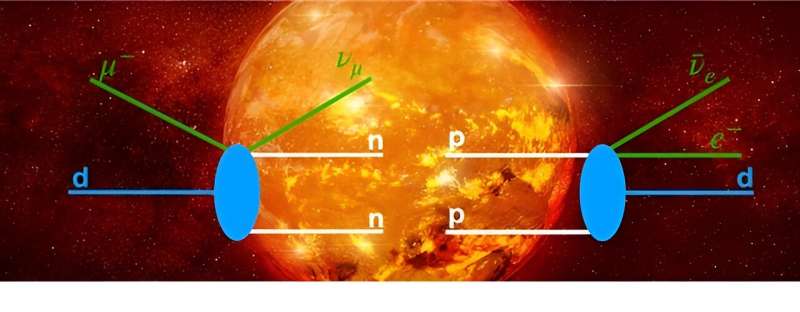This article has been reviewed according to Science X's editorial process and policies. Editors have highlighted the following attributes while ensuring the content's credibility:
fact-checked
trusted source
proofread
Exploring stellar hydrogen burning via muons and nuclei

The muon is a subatomic particle that resembles an electron but is 200 times heavier. It interacts with nuclei through the weak force, one of the four fundamental forces in the universe. When a muon binds with a deuteron (composed of one proton and one neutron), it forms a system with two neutrons. This process is analogous to proton-proton fusion, where two protons combine to form a deuteron.
This is a crucial step in how stars produce energy. Although laboratory studies of proton-proton fusion are impractical, calculations for muon capture offer valuable insights.
A collaborative team of nuclear theorists including researchers from the University of Pisa and the Istituto Nazionale Fisica Nucleare in Italy, the Theory Center at the Thomas Jefferson National Accelerator Facility, and Washington University in St. Louis has conducted a novel study focusing on muon capture on the deuteron. To investigate this process, the researchers used advanced models derived from chiral effective field theory and consistent currents.
Their research, published in Frontiers in Physics, investigated the muon capture rate using advanced models for describing the interaction among nucleons and their interactions with the muons. The adopted theoretical framework allowed the researchers to identify the principal sources of uncertainties and to quantify their effects. They compared the effectiveness of this approach with results in previous studies. This comparison found an uncertainty of approximately 2%, currently lower than experimental errors.
This study supports ongoing efforts to enhance the accuracy of muon capture measurements. It also paves the way to using the same theoretical framework to study proton-proton fusion and other processes. These studies will help scientists model the hydrogen burning phase of stars and understand solar neutrino fluxes.
In the future, the authors aim to extend the study to include muon capture processes on helium-3 and lithium-6, comparing the results with previous studies. They also intend to apply this framework to investigate other weak processes relevant to solar standard models and solar neutrino fluxes, such as proton weak capture on another proton and on helium-3 (hep reaction). These endeavors will provide valuable insights into astrophysical S-factor values at zero energy, accompanied by estimations of the associated theoretical uncertainties.
More information: L. Ceccarelli et al, Muon capture on deuteron using local chiral potentials, Frontiers in Physics (2023). DOI: 10.3389/fphy.2022.1049919
Provided by US Department of Energy





















